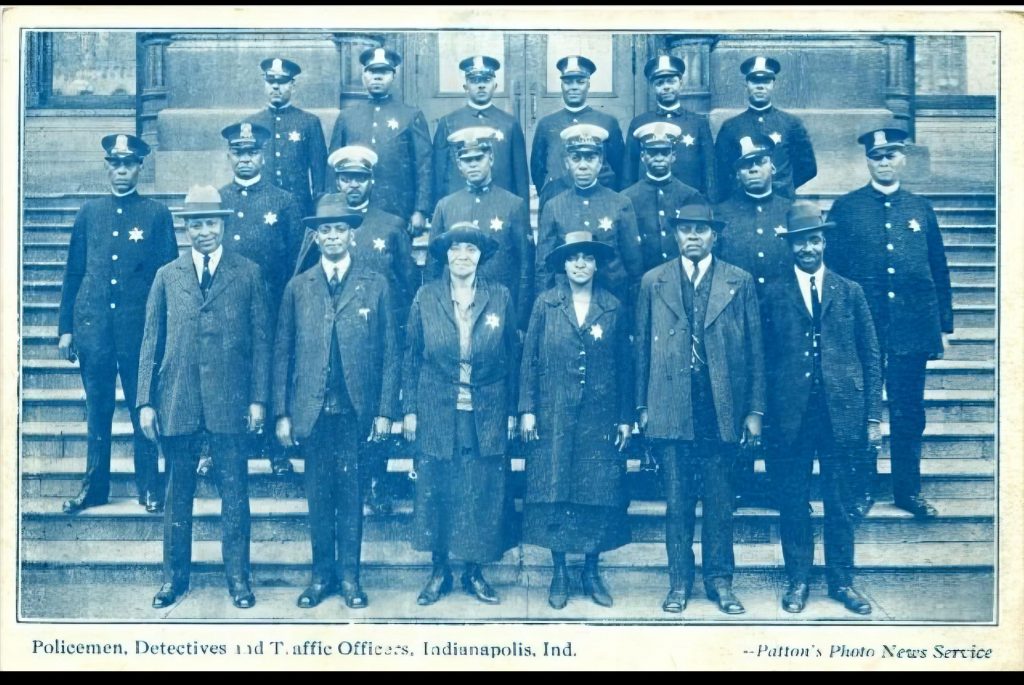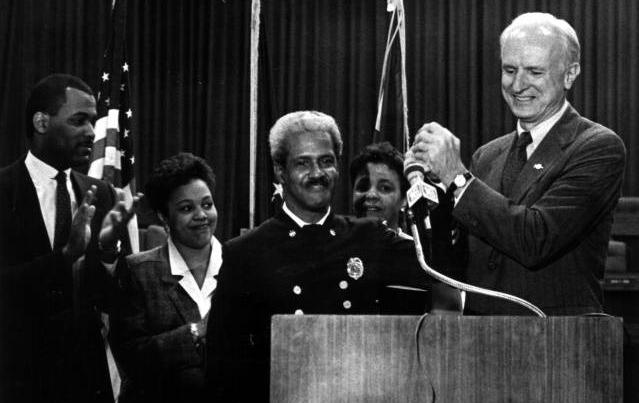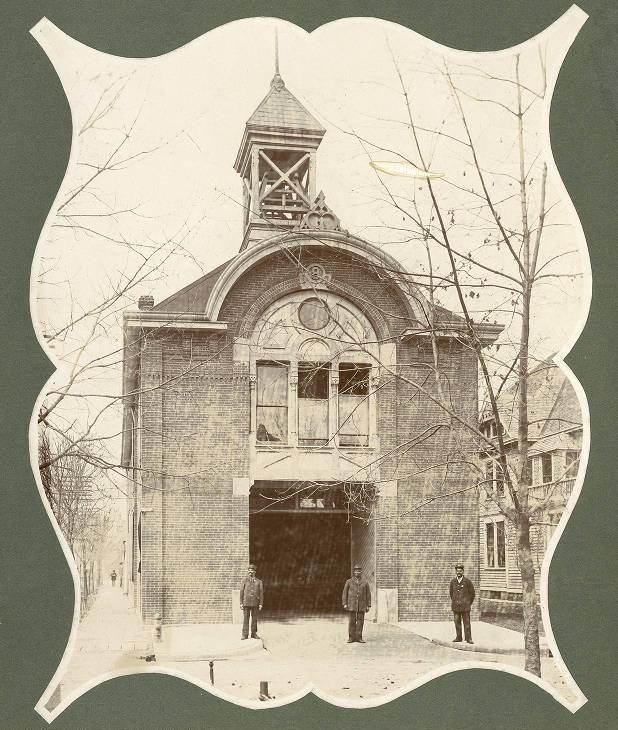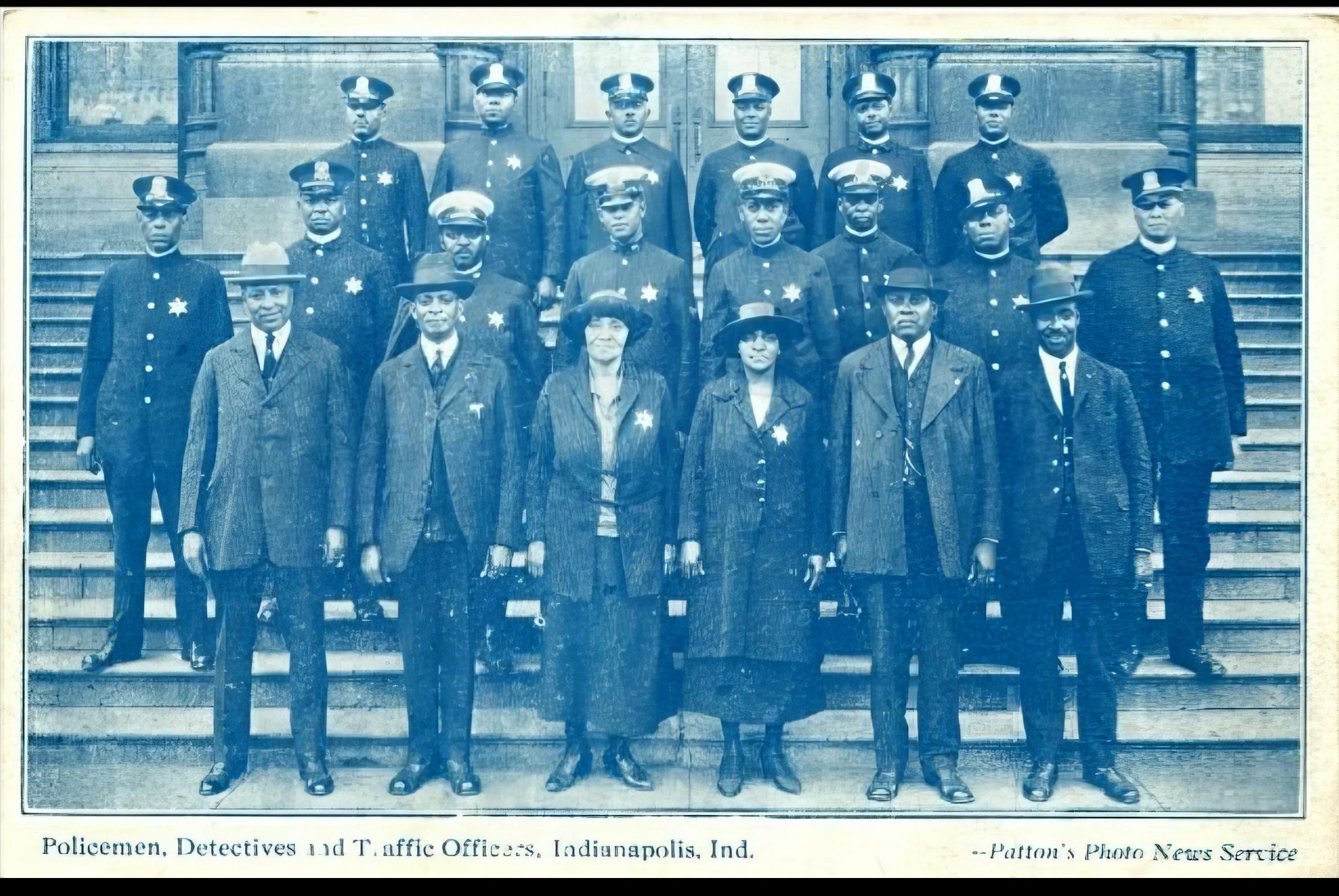Women and African Americans have made contributions to public safety in Indianapolis for well over 100 years, but their service in the ranks of both police and fire departments has come only because of their persistent pressure against discrimination.

Women in Public Safety
The impetus for employing women in police work dates to 1845 with the successful agitation of the American Female Reform Society to place matrons in New York City jails. After the 1880s the Women’s Christian Temperance Union (WCTU) led the campaign and by 1900 most major cities employed jail matrons. The duties of such “policewomen” were limited strictly to juveniles and women, a clientele universally held to be suited to their “maternal instincts.” The matrons—policemen’s widows or, more commonly, trained social workers—were often paid wholly or in part by private groups.

In Indianapolis, the office of police matron was established as part of the police force by the board of public safety in April 1891. The first matron, Annie Buchanan, operated from a room furnished by the local WCTU on the second floor of the station house. Buchanan counseled boys under 15, girls, and women, and decided whether to send them to institutions such as reform school, the Home for Friendless Women, or Children’s Guardian, or whether to hold them for trial.
Buchanan’s success led to an 1895 state law mandating matrons in every city and a similar law in 1901 for county jails. By 1914 Indianapolis employed three matrons and a female probation officer. In 1917 a report by the New York Bureau of Municipal Research advocated the appointment of Indianapolis policewomen to operate outside the station house. The following year Clara Burnside, an experienced social worker and for 12 years a juvenile court probation officer, was given the rank of sergeant and appointed supervisor of 13 women police, including two Black women, Emma Christy Baker and Mary Roberts Mays. In civilian attire and unarmed, their beats were the dance halls, movie houses, parks, restaurants—places where children and women might encounter vice.

By 1920, 16 women under Lieutenant Burnside (captain in 1921) dealt with shoplifters, runaways, and young girls on the streets. Counseling continued to be emphasized with arrest as the last resort. By 1939, however, the 23 policewomen of 1921 had declined to 14 who performed only as matrons, clerks, or telephone operators. The shortage of manpower during World War II brought a breakthrough for women in IPD, as was true for women’s employment generally. In November 1943, two armed, uniformed policewomen were assigned to traffic posts on . The gains did not last. Although about 30 women were hired during the war, in 1947 the number on the force fell to 26, of which six worked “on the street” and were armed. Even these officers were usually not in uniform.
Departmental hostility to policewomen and notions that women could not handle real police work—as late as 1968 typing was a requirement for female officers—continued unabated through the 1970s. Starting pay was equal, but policewomen, believing it a useless exercise, did not sit for promotion exams. When IPD became the first department in the nation to assign women to patrol cars (the announced purpose was to free men for crime-fighting), officers Betty Blankenship and Elizabeth Robinson were given one day’s notice, no training, and limited to service runs.

A 1972 Police Foundation study of policewomen in seven cities found Indianapolis represented both the best and the worst. IPD led in assigning women to patrol cars (eight by 1972), but 60 of 74 had office jobs, with more than half working as secretaries. Moreover, disdain for women within IPD was marked.
The real revolution for minorities in public safety in Indianapolis began with the 1975 lawsuit alleging discrimination filed by seven Black policemen. In January 1976, the new administration of Mayor voluntarily inaugurated an affirmative action program for all city departments, and in 1978 and 1979 it signed consent decrees on race and sex with the U.S. Department of Justice, which made hiring goals for minorities in public safety legally binding on the city.
One of the effects of the consent decrees was to bring women into the fire department. In 1978, IFD hired Bryona Slaughter, also an African American, as its first female firefighter. Women having a permanent presence in IFD dates to 1980 with the appointments of Valarie High and Nancy Sweeney. Still in 1992, while 145 women constituted 14.7 percent of IPD, they were only 2.8 percent (21) of the city’s firefighters, a circumstance attributable to the even greater competition for selection to IFD, greater physical demands, and a longer “male-only” tradition (the first woman, a civilian clerk, was hired in 1950, 60 years after the first jail matron).
African Americans in Public Safety

African American males appeared on the rolls of the Indianapolis Police Department (IPD) and Indianapolis Fire Department (IFD) in 1876, yet until well after World War II their numbers were few: 5 of 71 policemen in 1890; 16 of more than 400 in 1934. Also, Blacks invariably served in lower ranks. Not until 1973, for example, did an African American hold a top administrative position in IPD. Joseph Kimbrew became the first African American fire chief in 1987.
Both IPD and IFD were also segregated. Until the 1960s African American policemen worked in what were then the two predominately Black areas of the city and they lacked the right to arrest white criminal suspects. At best, a Black police officer in Indianapolis could detain the alleged criminal and call for a white police officer to make the arrest. Black firemen were restricted to all-Black Fire Station No. 1, originally Hose Company No. 9, at 1602 Carrollton Avenue which later moved to 441 Indiana Avenue. The Carrollton Avenue station, built in 1881 was home to the first four African American firefighters in Indianapolis: foreman Robert Braxton, James Graves, Thomas Howard, and Thomas Smith. Smith was the first African American fireman to die in the line of duty when the College Avenue streetcar struck Smith’s horse-drawn wagon on November 8, 1911. Integration of the fire stations began January 1, 1960, when four African American firemen transferred to two other stations. Two years later six whites (including a captain and a lieutenant) moved to Station No. 1. By 1974, 18 of the then 33 fire stations were integrated.

Affirmative action in hiring and promoting minorities has been accompanied by charges of favoritism from white males, countercharges by Blacks and women of persistent discrimination, and lawsuits. Yet the changes in race and gender in public safety institutions remain remarkable: From 1978 to 1992 minorities in IPD rose from 18 to 29.3 percent; in IFD from 9.3 to 21.8 percent. In 1990 Indianapolis ranked fifth among 18 big cities in the proportion of Black police officers compared to the size of the African American population.
By 2017, however, these numbers had not improved much. Of the 1219 individuals employed by IFD, 23.2 percent were minorities, covering all categories. While African Americans made up 28 percent of the Indianapolis population, only 15.6 percent of the firefighters working for IFD were African American. Women only represented only a little over 5 percent of the total. In 2019, African Americans made up only 14 percent of the Indianapolis police force. IFD and IMPD, therefore, actively sought a more diverse workforce. Mayor Joe Hogsett named Randal Taylor, an African American, as chief of police in January 2019. He previously had served as an assistant chief within the department.
Since 1882, IMPD has had 62 officers die in the line of duty. Only two of these officers were women, both of whom were responding to domestic violence calls at the time of their deaths. IMPD Officer Teresa Hawkins was killed in August 1993 when her police vehicle was hit by a drunk driver while she was on her way to respond to the domestic disturbance call. She was just 28 years old. IMPD Officer Breann Leath was the second woman, and first Black woman, to die in the line of duty. The 24-year-old Leath was shot on April 9, 2020, outside of the apartment she and several officers were called to for a domestic violence incident.
The deaths of Dreasjon Reed and McHale Rose and protests that ensued in Indianapolis and throughout the nation following the death of George Floyd in Minnesota strained relations between the African American community and police and brought greater attention to the need for better minority and gender representation within the ranks of public safety departments in Indianapolis and elsewhere.

Help improve this entry
Contribute information, offer corrections, suggest images.
You can also recommend new entries related to this topic.


